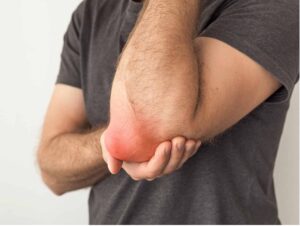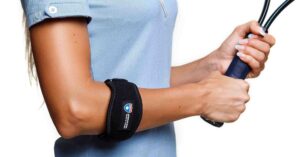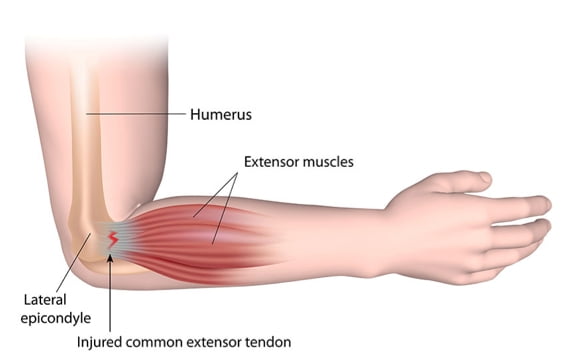Tennis elbow, or lateral epicondylitis, can cause considerable discomfort, impairing daily activities and your quality of life. While it is often associated with tennis players, this condition can affect anyone who engages in activities that strain the forearm muscles. But fear not! Help is on the way. Our comprehensive guide is designed to provide you with a better understanding of tennis elbow treatment options available to help you manage and overcome this condition.
Contents
Does Tennis Elbow Heal On Its Own?
 Yes, tennis elbow often can and does heal on its own over time. However, the timeframe for natural recovery can be quite long, typically ranging from six months to two years. This is depending on the severity of the condition. This is because the small tears in the tendons that attach your forearm muscles to the bones at your elbow caused by overuse and stress need time to heal.
Yes, tennis elbow often can and does heal on its own over time. However, the timeframe for natural recovery can be quite long, typically ranging from six months to two years. This is depending on the severity of the condition. This is because the small tears in the tendons that attach your forearm muscles to the bones at your elbow caused by overuse and stress need time to heal.
The healing process is often slow due to the low blood supply to these tendons. This slows the body’s natural healing response. Therefore, while the body can repair itself naturally, it is not always a quick process.
However, it’s important to note that while tennis elbow can heal on its own, this doesn’t mean that treatment should be ignored. Treatment can significantly speed up recovery time and help alleviate the discomfort and functional limitations associated with tennis elbow.
What Are Some Tennis Elbow Treatment Options?
There are several tennis elbow treatment options available, depending on the severity of the condition. And the specific needs of the individual. Here are some commonly used treatments:
Rest and Activity Modification
One of the most effective treatments for tennis elbow is simply to rest the affected arm and avoid activities that cause pain. This allows the small tears in the tendons that attach your forearm muscles to the bones at your elbow to heal. Activity modification might involve changes to the way you move your arm, lift heavy objects, or perform certain repetitive tasks. In the case of athletes, refining the techniques or motions that led to the condition in the first place can also be part of activity modification.
Physical Therapy
A physical therapist can teach you exercises to gradually stretch and strengthen your forearm muscles, particularly the extensor muscles. They may also use manual therapy techniques, such as massage and manipulation, to promote healing and reduce pain. Furthermore, they can advise you on ergonomic adjustments, like improving your posture or modifying your workstation, to prevent future problems.
Pain Management
Over-the-counter nonsteroidal anti-inflammatory drugs (NSAIDs), like ibuprofen and naproxen, can help reduce pain and inflammation in the short term. Topical NSAIDs and creams that contain pain-relieving medicines, like lidocaine. These can also provide relief when applied directly to the area of pain.
Bracing or strapping
 Using a special type of brace or strap, often called a counterforce brace, can help to reduce the strain on your elbow. This brace is usually worn around the forearm just below the elbow. And can be particularly helpful when you need to use your arm for some activities.
Using a special type of brace or strap, often called a counterforce brace, can help to reduce the strain on your elbow. This brace is usually worn around the forearm just below the elbow. And can be particularly helpful when you need to use your arm for some activities.
Steroid Injections
Corticosteroids are powerful anti-inflammatory medicines that can be injected into the painful area around your elbow. They can provide rapid relief from severe pain. However, the benefits are usually temporary, and repeated injections can cause side effects, including weakening of the tendon.
Extracorporeal Shock Wave Therapy (ESWT)
ESWT delivers sound waves to the affected area to stimulate healing within the tendon. It’s a non-invasive treatment that can be administered without the need for anesthesia. ESWT may be used when other conservative treatments haven’t been effective, though the clinical evidence on its effectiveness is mixed.
Platelet-Rich Plasma (PRP) Therapy
PRP therapy involves drawing a small amount of your blood, processing it to isolate the platelets — blood cells that contain high levels of growth factors — and then injecting this concentrated solution into the injured area. The idea is that the growth factors in the PRP can stimulate and enhance your body’s natural healing process. Research on PRP for tennis elbow is ongoing, with some studies suggesting it may be effective, but it is not universally accepted as a first-line treatment option.
Surgery
If the pain from the tennis elbow continues after more conservative treatments have been tried for a considerable period (typically at least six months), a doctor might suggest surgery. The procedure can remove damaged tissue and repair the tendon. Surgery can be performed through a large incision, or via a minimally invasive technique, using small incisions and special surgical instruments. The choice depends on the specifics of the case and the surgeon’s preference.
Dry Needling
This technique involves inserting a thin needle directly into the trigger points (the knots that form when muscles do not relax) in your muscles. These points are often located in the forearm muscles in cases of tennis elbow. The needles help to break up these knots and stimulate blood flow to the area. This can aid in the healing process.
Acupuncture
This traditional Chinese therapy involves the insertion of thin needles into specific points on the body to rebalance the body’s energy and stimulate healing. Acupuncture may help to relieve the pain of the tennis elbow and promote recovery. Although the effectiveness of acupuncture can vary between individuals.
Ultrasound Therapy
Therapeutic ultrasound uses sound waves to create gentle heat that can help to increase blood flow to the injured area, promoting healing and reducing inflammation. A small handheld device is used to send sound waves into the tissue. That can aid in reducing pain and speeding recovery.
Cold Laser Therapy
It is also known as low-level laser therapy. This non-invasive procedure uses low levels of light to stimulate healing in the body. Unlike surgical lasers, these don’t heat body tissues, but instead, they work at a cellular level to promote healing, reduce inflammation and pain.
Each of these treatment options offers different advantages. And the best course of action can vary depending on individual factors such as the severity of the condition, the patient’s overall health, and their personal preferences. Always consult a healthcare provider to discuss the best treatment plan for you.
What Exercises Can Help In Tennis Elbow?
 Exercise is an essential part of managing and recovering from tennis elbow. Physical therapy and specific exercises can help strengthen your forearm muscles, improve flexibility, and promote healing by increasing blood flow to the area. Here are some exercises that are often recommended:
Exercise is an essential part of managing and recovering from tennis elbow. Physical therapy and specific exercises can help strengthen your forearm muscles, improve flexibility, and promote healing by increasing blood flow to the area. Here are some exercises that are often recommended:
- Wrist Extension
Sit in a chair with your forearm resting on a table or your knee, palm facing down. Hold a lightweight (such as a soup can or small dumbbell), slowly lift the weight by extending your wrist, and then slowly lower it. Repeat 10-15 times.
- Wrist Flexion
This exercise is similar to the wrist extension but with your palm facing up. Slowly lift the weight by bending your wrist upward, then lower it. Repeat 10-15 times.
- Supination and Pronation of the Forearm
Hold a weight in your hand with your elbow at a 90-degree angle, and your forearm parallel to the floor. Rotate your forearm so that your palm faces the ceiling (supination). Then rotate it so your palm faces the floor (pronation). Repeat 10-15 times.
- Fist Clench
Rest your forearm on a table with your hand hanging over the edge, palm up. Hold a small ball (like a tennis ball) in your hand and squeeze it for about 10 seconds, then release it. Repeat 10-15 times.
- Towel Twist
Hold a towel with both hands and wring it out by twisting it in both directions. This exercise helps improve the strength and flexibility of the forearm muscles.
- Stretching Exercises
Stretching can help to improve flexibility and reduce stiffness in the forearm. Extend your arm out in front of you with your palm facing up. Use your other hand to gently pull the fingers down, stretching the forearm. You can also do this stretch with the palm facing down.
Remember to consult with a physical therapist or healthcare provider before beginning any new exercise program, especially if you’re experiencing pain. They can ensure that the exercises are appropriate for your condition and can be performed correctly, reducing the risk of further injury.
Conclusion
In conclusion, tennis elbow treatment can be challenging, but understanding the condition and the various options available is the first step to recovery. From rest and activity modification to physical therapy, medication, or even surgery, there are many ways to address the pain and discomfort caused by tennis elbow. Remember that the effectiveness of these treatments can vary between individuals. And it’s crucial to consult with a healthcare provider to find the most suitable approach for you.
With proper treatment and management, there is every reason to expect a full return to normal function and activities. Even if you’ve been grappling with this condition for a while. It’s all about finding the right balance of treatment, patience, and persistence.
If you’re experiencing Elbow pain, physical therapy for elbow pain at PhysioMantra can help: Book an online physical therapy session.



